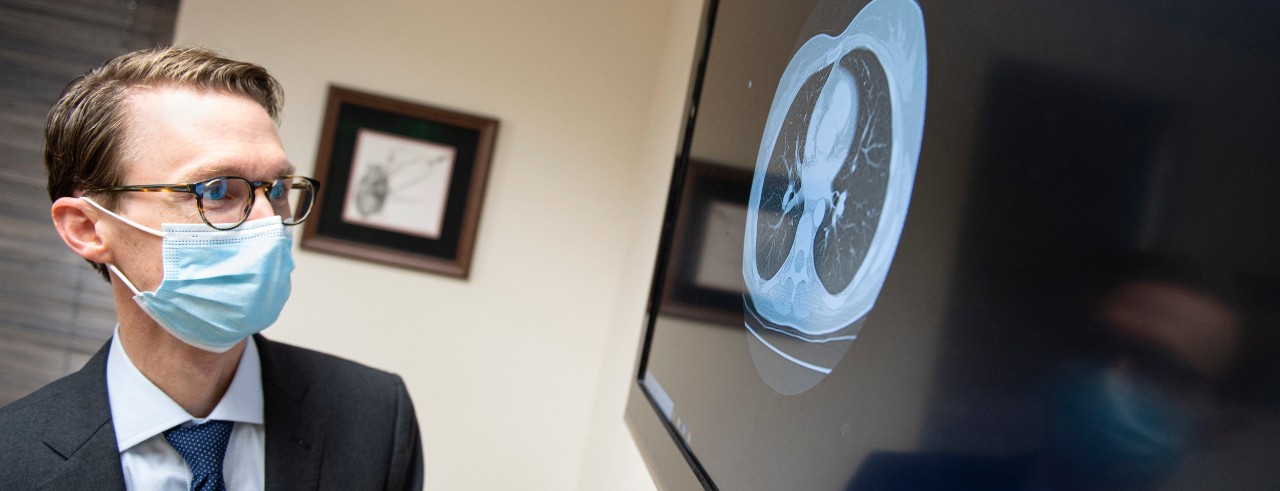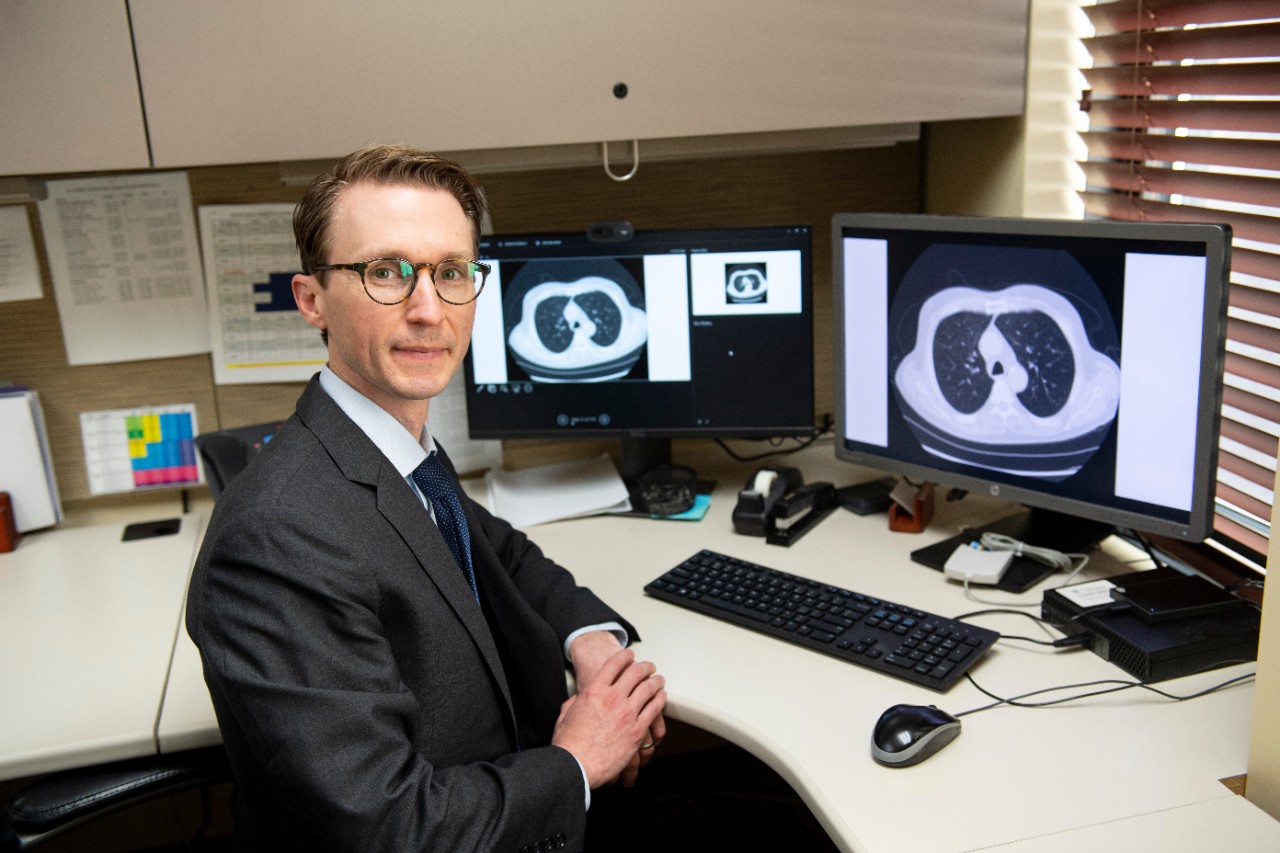
Study: the pandemic’s impact on lung cancer
UC study shows that the pandemic negatively affected both preventive screening and patient outcomes
When the pandemic hit the U.S. in early 2020, many routine activities came to a halt.
The same occurred with doctors’ visits — regular checkups and screening for many health conditions.
A recent study led by University of Cincinnati Cancer Center researchers shows the impact the pandemic had on lung cancer screening, which experts say could be bad for both screening programs in general and for the overall well-being of patients. The article appears on the website of the Journal of the American College of Surgeons in advance of print.
Robert Van Haren, MD, assistant professor of surgery at UC, a UC Health thoracic surgeon and corresponding author on the study, says low-dose radiation CT scans have been shown to catch lung cancer earlier. He adds that lung cancer is the leading cause of cancer death in the U.S., but if it’s detected early, it has cure rates as high as 90%. UC created the first lung cancer screening program in the region, Van Haren adds.

Robert Van Haren, MD, assistant professor of surgery at UC, a UC Health thoracic surgeon and member of the UC Cancer Center, says the COVID-19 pandemic caused a shutdown for the lung cancer screening program, which resulted in fewer screening appointments and poorer outcomes for patients. Photo credit/Colleen Kelley
CT scans combine a series of X-ray images taken from different angles around the body and then use computer processing to create images of “slices” of the bones, blood vessels and soft tissues inside the body. These images provide more detailed information than plain X-rays do.
Van Haren explains that like many programs, the COVID-19 pandemic caused a shutdown for the lung cancer screening program, but researchers wanted to find out how much of an impact that shutdown had on overall numbers of patients screened as well as cancer diagnoses.
He says that, nationally, diagnoses for many conditions, like appendicitis, heart attack and stroke, decreased during the pandemic and that evidence from the United Kingdom showed nearly a 5% increase in lung cancer deaths due to delaying a diagnosis during the pandemic.
The team used a database of patient information and outcomes to compare monthly average screenings between January 2017 and February 2020 against the COVID-19 shutdown period of March 2020 to July 2020.
The most concerning thing we found was that suspicious places in the lungs that could be cancerous increased after we reopened. This means that if the shutdown never occurred, we could have potentially found and treated issues earlier.
Robert Van Haren, MD

Robert Van Haren, MD, on the bridge in the CARE/Crawley Building on UC's medical campus. Photo credit/Colleen Kelley.
“When low-dose radiation CT scans were stopped on March 13, 2020, 818 screening visits were canceled,” he says. “We began gradually reopening on May 5 and then fully opened again on June 1. Total monthly CT scans and new patient monthly scans significantly decreased during the COVID-19 period we analyzed, and new patient scans have remained low despite resuming full operations.
“The most concerning thing we found was that patients with lung nodules, or suspicious places in the lungs that could be cancerous, increased after we reopened. This means that if the shutdown never occurred, we could have potentially found and treated issues earlier.”
Van Haren adds it is sometimes difficult to get patients that qualify for lung cancer screening to participate in the first place. To qualify, patients must be 55 to 80 years old and have smoked at least one pack of cigarettes per day for 30 years or two packs of cigarettes a day for 15 years.
“Lung cancer screening was approved in the last several years, and a large number of patients who are eligible already do not get screened. So, when we had to cancel new patient appointments, we lost momentum for some of these patients who could benefit from lung cancer screening,” he says.
“COVID-19 caused a significant disruption in lung cancer screening, leading to a decrease in new patients screened and an increased proportion of suspicious nodules once screening resumed,” he adds. “By using lung cancer and our screening program as a model, this early analysis shows the consequences related to the pandemic for both screening programs and cancer care. We hope that it can provide some insight into how we deal with operations as the pandemic continues.”
Featured photo of Robert Van Haren, MD, by Colleen Kelley.
Impact Lives Here
The University of Cincinnati is leading public urban universities into a new era of innovation and impact. Our faculty, staff and students are saving lives, changing outcomes and bending the future in our city's direction. Next Lives Here.
Stay up on all UC's COVID-19 stories, or take a UC virtual visit and begin picturing yourself at an institution that inspires incredible stories.
Other authors, all from the University of Cincinnati, include lead author Sandra Starnes, MD; Aaron Delman, MD; Kevin Turner, MD; Brandy Waits; Mona Hemingway; and Shimul Shah, MD.
Related Stories
Esteemed gamers pack 1819 for Esports Ohio Regionals
April 24, 2025
Leading high school video gamers filled the 1819 Innovation Hub in early April to compete during Esports Ohio’s regional championship.
Why can perimenopause make migraines worse?
April 23, 2025
Experts say women who have migraine symptoms linked to their menstrual cycle are prone to migraine problems during perimenopause.
UC study finds vision loss fear may keep some from having...
April 23, 2025
A new University of Cincinnati study finds vision loss fears may deter some patients from cataract surgery, despite it being the only effective treatment. The research underscores the role of doctor-patient relationships in medical decisions.
